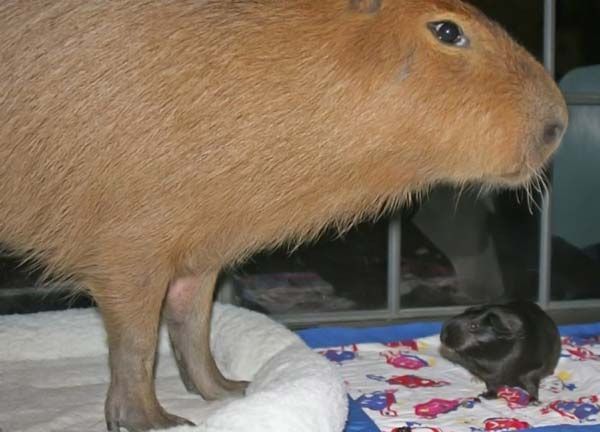|
|
Caplin Rous Capybara
|
Capybaras are very gregarious. While they do sometimes live solitarily they are more commonly found in groups that average 10-20 individuals. With 2-4 of them being adult males, 4-7 being adult females and the rest being juveniles. Capybara groups can consist of as many as 50 or 100 individuals during the dry season, when the animals gather around available water sources. Males are organized in stable, linear hierarchies. The dominant male in each group is significantly heavier than any of the subordinates, but among subordinates, status is not correlated with weight. The dominant male is positioned in the center of the group while subordinates are on the periphery. These hierarchies are established early in life among the young with play fights and mock copulations. The most dominant males have access to the best resources. Capybaras are very vocal and, when in groups, chatter with each other to establish social bonds, dominance or general group census. They can make a dog-like bark which is made when the animals are threatened or when females are herding young. The bark of a capybara is often mistaken for that of a dog.
Capybara have two different scent glands; a morillo, located on the snout, and an anal gland. Both sexes have those glands but males have larger morillos and their anal pockets can open more easily. The anal glands of males are also lined with detachable hairs. A crystalline form of scent secretion is coated on these hairs and are release when in contact with objects like plants. These hairs have a longer lasting scent mark and are tasted by other capybaras. A capybaras marks by rubbing its morillo on an object or by walking over a scrub and marking with its anal gland. A cabypara can spread its scent further by urinating. However females usually mark without urinating and mark less frequently than males overall. Females mark more often during the wet season when they are in estrus. In addition to objects, males will also mark females.
• Reproduction
When in estrus, the female's scent changes subtly and nearby males begin pursuit. In addition, a female will alert males that she is in estrus by emitting a whistling noise though her nostrils. During mating, the female has the advantage and mating choice. Capybaras mate only in the water and if a female does not want to mate with a certain male she will either submerge or leave the water. Dominant males are highly protective of the females, however they usually can’t prevent all the subordinates from copulating. The larger the group, the harder it is for the male to watch all the females. Dominant males secure significantly more matings than each subordinate, but subordinate males, as a class, are responsible for more matings than each dominant male. The lifespan of the capybara's sperm is longer than that of other rodents.
|
|









